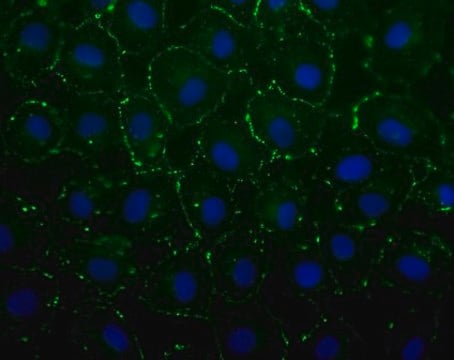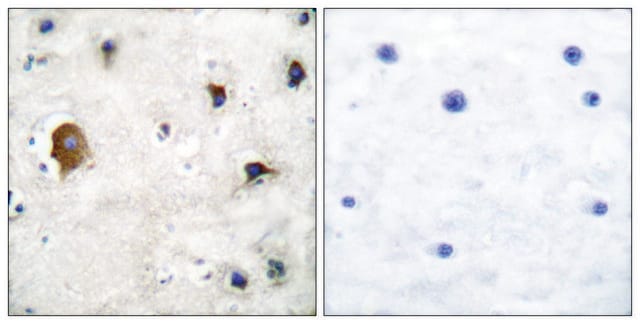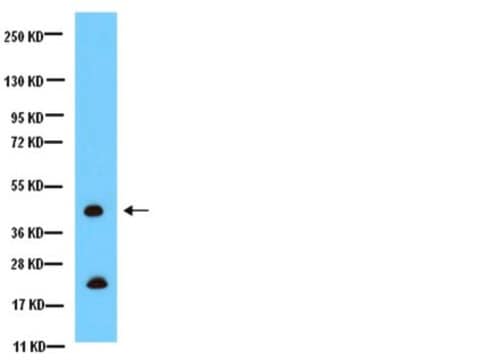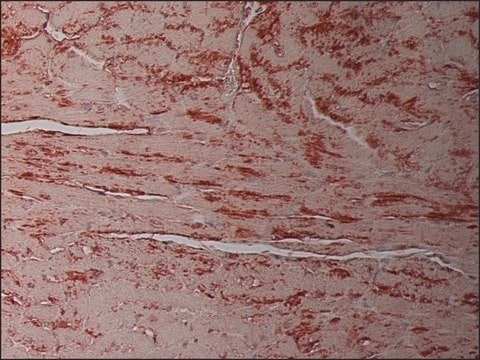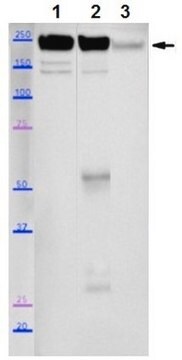AB1727
Anti-Connexin 43 Antibody
Chemicon®, from rabbit
Synonim(y):
Gap Junction alpha-1 Protein (CxA-1)
About This Item
Polecane produkty
pochodzenie biologiczne
rabbit
Poziom jakości
forma przeciwciała
affinity isolated antibody
rodzaj przeciwciała
primary antibodies
klon
polyclonal
oczyszczone przez
affinity chromatography
reaktywność gatunkowa
mouse, bovine, rat
producent / nazwa handlowa
Chemicon®
metody
ELISA: suitable
immunocytochemistry: suitable
immunohistochemistry: suitable
immunoprecipitation (IP): suitable
western blot: suitable
numer dostępu NCBI
numer dostępu UniProt
Warunki transportu
wet ice
docelowa modyfikacja potranslacyjna
unmodified
informacje o genach
human ... GJA1(2697)
Opis ogólny
a predicted M.W. of ~43 kDa. It is prominently expressed in heart (see reviews: Kumar & Giula 1996; White et al. 1995; Evans 1994; Beyer et al. 1990).
Specyficzność
Immunogen
corresponding to amino acids 360-382 within
the C-terminus of mouse connexin 43.
Zastosowanie
Immunocytochemistry: not tested. It is recommended that the antibody be tried at 2-20μg/mL in formaldehyde fixed (Beyer et al. 1985; Nicholson et al. 1985; John et al. 1991; Fishman et al. 1990).
Immunoblotting: 1-10μg/mL using Chemiluminescence technique.
Optimal working dilutions must be determined by end user.
Immunohistochemistry: A 1:50 dilution of this antibody detected Connexin 43 in sections from mouse heart tissue pretreated with Tris-EDTA buffer, pH 9.0. Proteins were visualized using a donkey anti-rabbit secondary antibody conjugated to HRP and chemiluminescence detection.
Cell Structure
Adhesion (CAMs)
Postać fizyczna
Przechowywanie i stabilność
Informacje prawne
Oświadczenie o zrzeczeniu się odpowiedzialności
Not finding the right product?
Try our Narzędzie selektora produktów.
polecane
Kod klasy składowania
12 - Non Combustible Liquids
Klasa zagrożenia wodnego (WGK)
WGK 1
Temperatura zapłonu (°F)
Not applicable
Temperatura zapłonu (°C)
Not applicable
Certyfikaty analizy (CoA)
Poszukaj Certyfikaty analizy (CoA), wpisując numer partii/serii produktów. Numery serii i partii można znaleźć na etykiecie produktu po słowach „seria” lub „partia”.
Masz już ten produkt?
Dokumenty związane z niedawno zakupionymi produktami zostały zamieszczone w Bibliotece dokumentów.
Nasz zespół naukowców ma doświadczenie we wszystkich obszarach badań, w tym w naukach przyrodniczych, materiałoznawstwie, syntezie chemicznej, chromatografii, analityce i wielu innych dziedzinach.
Skontaktuj się z zespołem ds. pomocy technicznej
